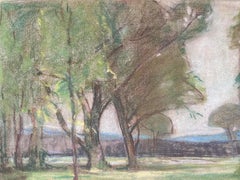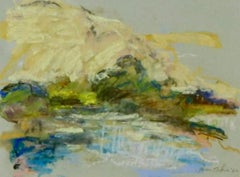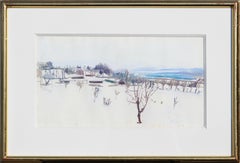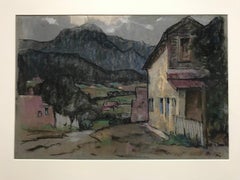Louis Raynaud Art
b. 1905
Louis Raynaud was born in New Orleans and was a resident there and in Chicago, where he was active in the Society for Sanity in Art. He was also a member of the New Orleans Art Association, the Southern States Art League and the New Orleans Arts and Crafts Club. Raynaud’s exhibition venues included the Society of Independent Artists, the New Orleans Art Association and the New Orleans Art League. Raynaud was a WPA artist for the Federal Art Program and did post office murals in St. Louis, Missouri and Abbeville, Louisiana.
to
1
Overall Width
to
Overall Height
to
1
1
1
1
1
1
10,025
2,754
1,379
1,375
1
Artist: Louis Raynaud
Trees in a Landscape (New Orleans, Southern States Art League, WPA, b. 1905)
By Louis Raynaud
Located in New Orleans, LA
This fine pastel was one of two we acquired together, one signed, this one unsigned, but undoubtedly by New Orleans artist Louis Raynaud, not only obvious from the style but also bec...
Category
Early 20th Century Louis Raynaud Art
Materials
Pastel
Related Items
Abstract Landscape Mid 20th Century Work on Paper Hamptons, NY Drawing Pastel
By Robert Dash
Located in New York, NY
Abstract Landscape Mid 20th Century Work on Paper Hamptons, NY Drawing Pastel. Signed and dated '62 lower right. 9 x 12 inches (sight) and 15. 1/2 x 18 1/2 inches framed.
BIO
Robert Dash is known for his Hamptons paintings...
Category
1960s Abstract Louis Raynaud Art
Materials
Paper, Pastel
"The Winter Valley" Purple and Brown Toned Winter Landscape Townscape
By Wolf Kahn
Located in Houston, TX
Blue, purple, and green toned winter landscape pastel drawing by German-American painter, Wolf Kahn. Signed by the artist in the lower right corner. Framed and matted in a gold frame...
Category
1980s Abstract Louis Raynaud Art
Materials
Paper, Pastel
$9,500 Sale Price
26% Off
H 16.13 in W 24 in D 1.13 in
Framed Mid 20th Century Pastel, Polgigga
Located in Corsham, GB
This expressive pastel landscape shows fields near Polgigga, Cornwall. This drawing celebrates pattern and colour and offers us a scene that is overrun with nature. The drawing has b...
Category
20th Century Louis Raynaud Art
Materials
Pastel
Margit Oelenheinz (b.1926) - Mid 20th Century Pastel, The Alley
Located in Corsham, GB
A narrow composition to mirror the narrow alleyway depicted. Rendered in expressive pastel, Oelenheinz employs a palette which is colourful yet muted, giving the scene an otherworldl...
Category
20th Century Louis Raynaud Art
Materials
Pastel
$395
H 10.24 in W 11.42 in
"Natalie's" - Plein Aire Pastoral Landscape in Pastel on Sandpaper
Located in Soquel, CA
"Natalie's" - Plein Aire Pastoral Landscape in Pastel on Sandpaper
Serene plein aire landscape with cows by Clive R. Tyler (American, b. 1958). This composition depicts a farm in Fort Collins, Colorado, with a large white barn at the top of the hill. There are several cows grazing in a bright green pasture. A partially broken fence is directly in front of the viewer - a symbol of the artist's desire to portray the realism of the scene, including imperfections. This piece is executed on sandpaper, a trademark of Tyler's work.
Signed "CL Tyler" in the lower left corner
Signed, notated, titled, and dated on verso (see photo).
Presented in a silver colored frame.
Frame size: 11.25"H x 14"W
Paper size: 9.5"H x 12"W
Clive R. Tyler (American, b. 1958) studied Fine Art and Design at Kent State University (Ohio) with a double major and was awarded a Bachelor of Fine Art degree. Twenty years later after a successful design career, he is now known as one of the best Pastelists on a national level.
Master Member of the Plein Air Painters of New Mexico
Signature Member of the American Impressionist Society
2016 Honorable Mention, Santa Fe Plein Air Festival, NM
2015 Best Quick Draw Award, Buffalo Bill Museum Art Auction, Cody Wy
2015 Best of Pastel Award, American Impressionist Society
2015 Brinton Museum, Invitational Miniature show. Sheridan. Wy
2015 Invitational Heart of the West, Masters art show. Coeur d’Alene Resort, Id
2014 Booth Museum Cartersville Ga. Acquisition and Teaching
2014 Coors Foundation purchase Aspen 3 series. Corporate Collection Denver, Co
2013 American Impressionist National Show, Award of Excellence.
2013 Artist Choice Award Easton Maryland...
Category
Early 2000s American Realist Louis Raynaud Art
Materials
Paper, Pastel
$1,560 Sale Price
20% Off
H 11.25 in W 14 in D 1 in
1907 Pastel - Settling Dusk
Located in Corsham, GB
An atmospheric pastel landscape showing the glowing window of a cottage on the banks of a river, shining through the gathering dusk. The artist has signed indistinctly and dated to t...
Category
20th Century Louis Raynaud Art
Materials
Pastel
American Contemporary Art by Elena Borstein - Blue Gate III
By Elena Borstein
Located in Paris, IDF
Pastel on paper
Elena Borstein currently lives and works in New York City and the Adirondack Mountains. Born in Hartford, Connecticut, She received her B.S. Degree from Skidmore Col...
Category
1990s Contemporary Louis Raynaud Art
Materials
Paper, Pastel
$7,000
H 30 in W 40 in D 0.05 in
"Chilmark Pond", Martha's Vineyard Plein Air Coastal Island Pastel Landscape
Located in Soquel, CA
"Chilmark Pond", Martha's Vineyard Plein Air Coastal Island Pastel Landscape by Anne F. Cook
A lovely plein air pastel landscape capturing the natural beauty of New England's coastal island sunset views, by Martha's Vineyard artist Anne F. Cook (American, b.1962). This 1995 pastel, titled "Chilmark Pond", transports the viewer to the beautiful island of Martha's Vineyard, to bask in the soft light of dusk as the sun sets over the view of the island's coastal ponds.
Signed and dated "Cook 1995" lower right.
Titled "Chilmark Pond" lower left. Photo of title has been slightly enhanced to appear more legible.
Displayed in a decorative black and gilt-toned frame, with tan mat.
Image size: 18.5"H x 24.5"W.
Framed size: 26.25"H x 32.25"W x 1"D.
Anne Cook...
Category
1990s American Impressionist Louis Raynaud Art
Materials
Paper, Pastel
$2,000 Sale Price
20% Off
H 26.25 in W 32.25 in D 1 in
Machias Seal Island Light
By Wolf Kahn
Located in Milwaukee, WI
Wolf Kahn was commissioned by the Smithsonian to design a postcard for them. He made four designs and they selected a singular one. This drawing here is one of the few rejected designs. This piece was given to the founder, David Barnett, of the David Barnett Gallery...
Category
19th Century American Impressionist Louis Raynaud Art
Materials
Paper, Pastel
Crash Course, Original Signed Contemporary Impressionist Landscape Painting
By Dina Gardner
Located in Boston, MA
Crash Course, Original Contemporary Impressionist Landscape Painting
8" x 8" (HxW) Pastel on Paper
Hand-signed by the artist.
This modern impressionist seascape features a square co...
Category
21st Century and Contemporary Impressionist Louis Raynaud Art
Materials
Pastel, Paper
$375
H 8 in W 8 in D 0.1 in
American Contemporary Art by Elena Borstein - Thira VII Rooftops
By Elena Borstein
Located in Paris, IDF
Pastel on paper
Elena Borstein currently lives and works in New York City and the Adirondack Mountains. Born in Hartford, Connecticut, She received her B.S. Degree from Skidmore Col...
Category
2010s Contemporary Louis Raynaud Art
Materials
Paper, Pastel
$6,350
H 40 in W 60 in D 0.05 in
American Contemporary Art by Elena Borstein - Red Step
By Elena Borstein
Located in Paris, IDF
Pastel on paper
Elena Borstein currently lives and works in New York City and the Adirondack Mountains. Born in Hartford, Connecticut, She received her B.S. Degree from Skidmore Col...
Category
1990s Contemporary Louis Raynaud Art
Materials
Paper, Pastel
$6,000
H 30 in W 40 in D 0.05 in
Previously Available Items
Louis Reynaud "Farmhouse in Landscape" - 20th Century Pastel Landscape
By Louis Raynaud
Located in New Orleans, LA
A beautiful pastel of the (French? Italian?) countryside by a member of a group of artists who advocated against abstraction in the early to mid-20th century; he worked in a clearly post-Impressionist style. Lived and worked in New Orleans. Picture is matted, with a layer of glassine over the pastel for protection.
Proudly presented by Guy Lyman Fine Art, New Orleans, with our firm guarantee of satisfaction.
From the archives of AskArt:
A painter and teacher, Louis Raynaud was born in New Orleans and was a resident there and in Chicago where he was active in the Society for Sanity in Art. He was also a member of the New Orleans Art...
Category
Early 20th Century Impressionist Louis Raynaud Art
Materials
Pastel
Louis Raynaud art for sale on 1stDibs.
Find a wide variety of authentic Louis Raynaud art available for sale on 1stDibs. You can also browse by medium to find art by Louis Raynaud in crayon, pastel and more. Much of the original work by this artist or collective was created during the 20th century and is mostly associated with the Impressionist style. Not every interior allows for large Louis Raynaud art, so small editions measuring 18 inches across are available. Customers who are interested in this artist might also find the work of Tony Minartz, Henri Miloch, and Leonard Machin Rowe. Louis Raynaud art prices can differ depending upon medium, time period and other attributes. On 1stDibs, the price for these items starts at $720 and tops out at $720, while the average work can sell for $720.



